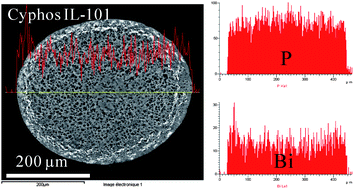Extractant impregnated resins (EIR) are conventional materials used for combining the potential of extractants (liquid/liquid extraction) and resin (sorption processes) for metal recovery. A new class of EIR has been recently developed based on the use of biological materials (especially biopolymers), renewable resources, for the encapsulation of these extractants. The development of a “new industry“ based on the properties of ionic liquids (ILs) opens the route for substituting conventional extractants with these ionic liquids. Biopolymers (such as alginate) can be used to immobilize extractants, profiting from their excellent encapsulation properties. This Highlight article describes, first, the process developed for immobilizing extractants and ILs using minerals or synthetic polymers, before focusing on IL-immobilization in biopolymer matrices. Special attention is given to the system Cyphos IL-101/alginate with application to the sorption of metals such as Pd(II), Pt(IV), Au(III), Hg(II), Bi(III), pointing out the controlling mechanisms and experimental parameters. The last section briefly identifies the potential applications of these processes for developing new materials.

You have access to this article
 Please wait while we load your content...
Something went wrong. Try again?
Please wait while we load your content...
Something went wrong. Try again?


 Please wait while we load your content...
Please wait while we load your content...